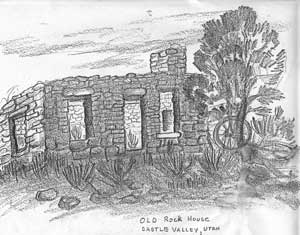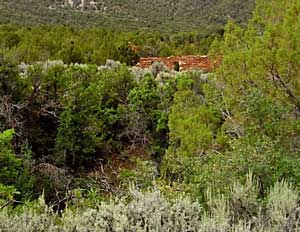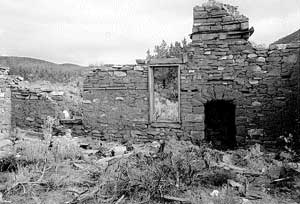
Pencil sketch from artist Dwain Barker collection shows detail of ruins in 1950s. |
If three is the charm, the “two-time loser” town of Castleton may escape total abandonment as a ghost town and experience revival as a cultural resource site worthy of the National Register of Historic Places.
Originally a mining camp that reached its zenith as a supply town for gold prospectors in the late 1880s, Castleton is a prime candidate for immediate stabilization, eventual restoration and protection, and development as a local cultural resource, according to research funded by the U.S. Bureau of Land Management.
Settled during the 1860s and frequented by placer gold miners, wandering cowboys and sheepherders, the 5-acre mining camp was reborn as a supply town in 1888 when gold in quartz was discovered at Miner’s Basin in the La Sal Mountains, according to George S. Thompson, author of Some Dreams Die: Utah’s Ghost Towns and Lost Treasures.
Thompson reported that Castleton hustled to keep up with miners’ needs as they worked veins in the La Sal Mountains, freight companies were kept busy, and a large general store, hotel, restaurant, livery stable, blacksmith shop, “Plug Hat” Kelly’s saloon and a deputy sheriff soon occupied the site. Other researchers reported claims of Castleton also boasting cobbler shops, a livery stable, a second saloon, doctor’s and mine offices, a Sunday school, post office and several homes, though some of the structures may actually have been located in the greater Castle Valley area.

Vegetation nearly obscures ruins of rock structure built in 1880s.
Photo by Vicki Barker |
Thompson termed Castleton a two-time loser after the mining-camp-turned-townsite suffered mass evacuation in the great financial panic of 1907 that closed hardrock mines and put miners out of work. The town that once competed with Moab for title as “county seat” had a population count of only 30 residents by 1930. After the cattlemen who provided any remaining financial support also moved on in the 1900s, the town reportedly died.
However, researcher Richard Fike, an archaeologist with the Museum of the Mountain West in Montrose, concluded in consultation with the BLM and Grand Historic Preservation Specialists group in Durango, that various remaining structures at the site are eligible for nomination to the National Register of Historic Places -- especially remains of a large stone ranch house that came to be known as the “Rock Castle”.
Occupants who reportedly called Castleton home included prospector Doby Brown in the late 1870s or 1880s (A History of Grand County, by Richard Firmage); John (or “Jack”) Welsh until his death in 1913; and J.E. Cooley, who sold the ranch in 1921 to Don and Max Taylor. Don Taylor sold the property to the BLM in 1945 when the agency was still referred to as the General Land Office.
Currently, D.L. Taylor, a member of the Grand County Historical Preservation Commission, is helping the Historical Sites and Places Committee research Castleton’s history from the period the Taylors lived there. Input from others acquainted with Castleton history is welcome.

Photo courtesy of the Bureau of Land Management (BLM) |
About 28 miles northeast of Moab, little remains of the dramatic rock castle, a nearby dugout and other remnants of Castleton. What can barely be seen of the 31 ½ x 32-foot sandstone structure is about half the height of the original 12-foot-high walls, and is now almost totally obscured by dense sage and rabbit brush, pinyon trees and other vegetation; and difficult to access through communities of cactus and the steep banks of Spring Creek, a tributary of Castle Creek.
Consultants on the assessment of potential for restoring some or all of the ranch complex warned that emergency repairs are needed or, in the short term, stabilization at minimum is needed to save the rock castle from total collapse, although the rock foundation is in excellent shape and the walls are “generally” intact.
The rock castle is the only standing remnant of the area’s earliest mining and ranching boom, and, being in public ownership, offers interpretive potential as part of a larger Millenium Trail designation that includes the Kokopelli Mountain Bike Trail and associated campgrounds and historic sites along the way, the BLM study concluded. The county’s historical board has listed the rock castle historical nomination as a priority project for several years. |


